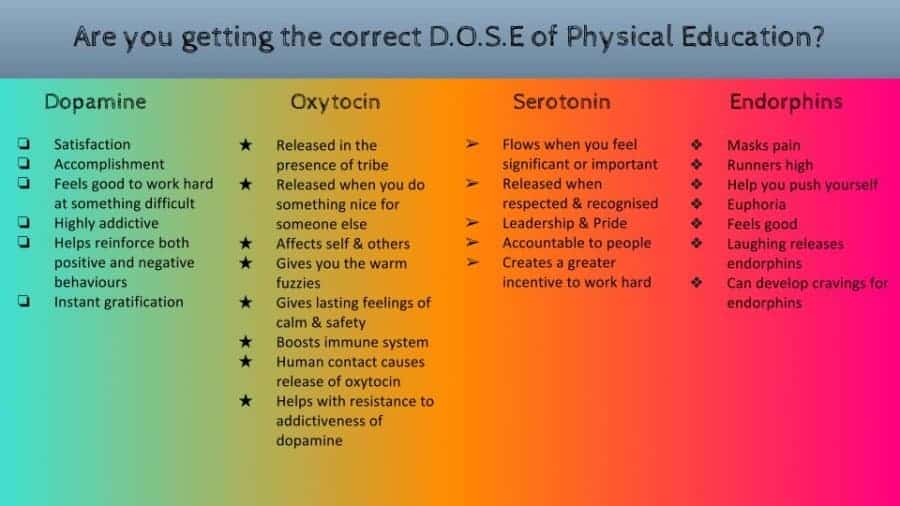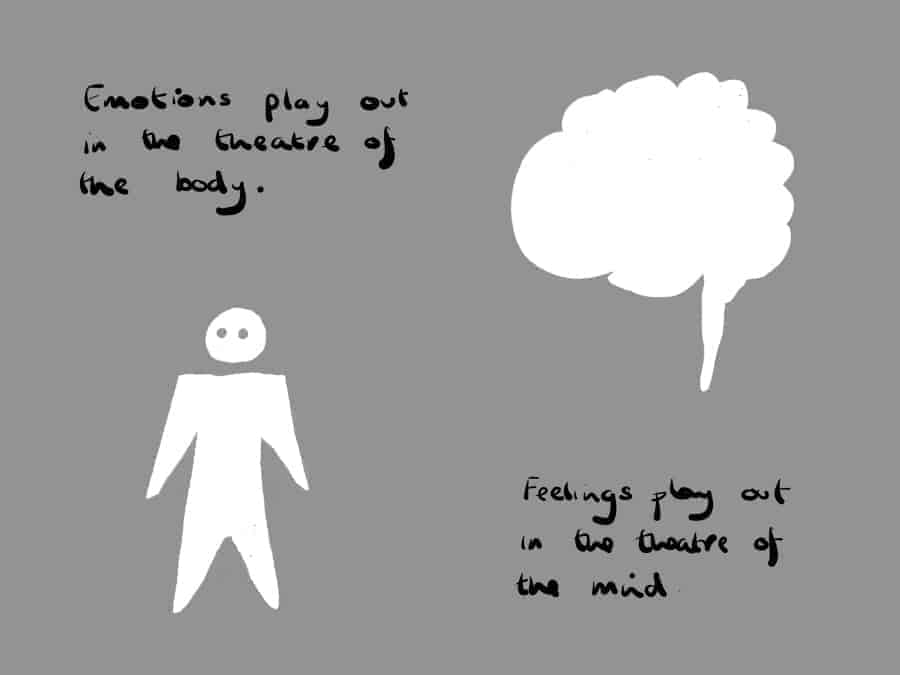The art of teaching, at its very core, is constant decision making and problem-solving in a dynamic environment to assist the individual or the collective to flourish. As a secondary school teacher of PE I believe I am faced with two key puzzles to solve. The first key puzzle is how can I ensure I do not put children off movement who have already found some meaning in it and have developed motor competence. The second key puzzle is how to help children develop motor competence and have yet to find any meaning in movement. Developing motor competence and exploring meaningful movement is at the heart of what a good PE curriculum should provide. Competence without meaning leads to aversion. Meaning without competence leads to frustration. It isn’t one or the other. It’s both deeply interconnected, building into a positive spiral of habitual daily movement.
For the vast majority of my career, I have focused meaning-making in PE around what Scott Kretchmar describes as the ‘prudential approach’ which is along the lines of the health and fitness guidance the Chief Medical Office gives. What are the benefits of being active for at least 60 minutes each day? It Improves cardiovascular health, helps to maintain a healthy weight, Improves bone health etc. As Kretchmar writes in Movement Subcultures: Sites for Meaning‘Addressed directly to students, it warns: if you do not adopt an active lifestyle, you will very likely decrease both the quality and the duration of your life. What could be more meaningful than that blunt and startling message?‘
The children who I have taught have got that message from me over and over again. I’m sure it is constantly being heard by other children, in other PE classes, in other schools. They are getting the message, they just don’t seem very motivated by it. The health-related reasons we give to make movement meaningful for children seem irrelevant to them. Michelle Seger, in her excellent book No Sweat, suggests that ‘future health benefits, such as disease prevention, are too abstract to overcome people’s inertia‘. In her research she finds human beings are usually motivated to choose immediate rewards over delayed benefits, ‘Logic doesn’t motivate us – emotions do‘.
With that in mind, I wanted to explore with my pupils, how movement could influence emotions, feelings and behaviours. Up until now, the affective learning domain of our curriculum focused mainly about defining good behaviours for learning and what quality practice looked and felt like. Exploring how the movement could impact on their feelings, hopefully in a positive manner, could help in making movement more meaningful for them than just the prudential message of health and fitness.
This is a brief overview of the unit of work that linked our Foundational Movements Programme(focused on improving squat, lunge, push, pull, twist, hinge and brace movements) to how participated in movement felt. Added to the overview is feedback from Dr Justen O’Connor, a researcher in Health and PE from Monash University. (Many teachers come to Twitter to find new ideas and resources, but I feel it offers so much more if you are willing to connect with others and share your practice for critique. His comments are in bold italics).
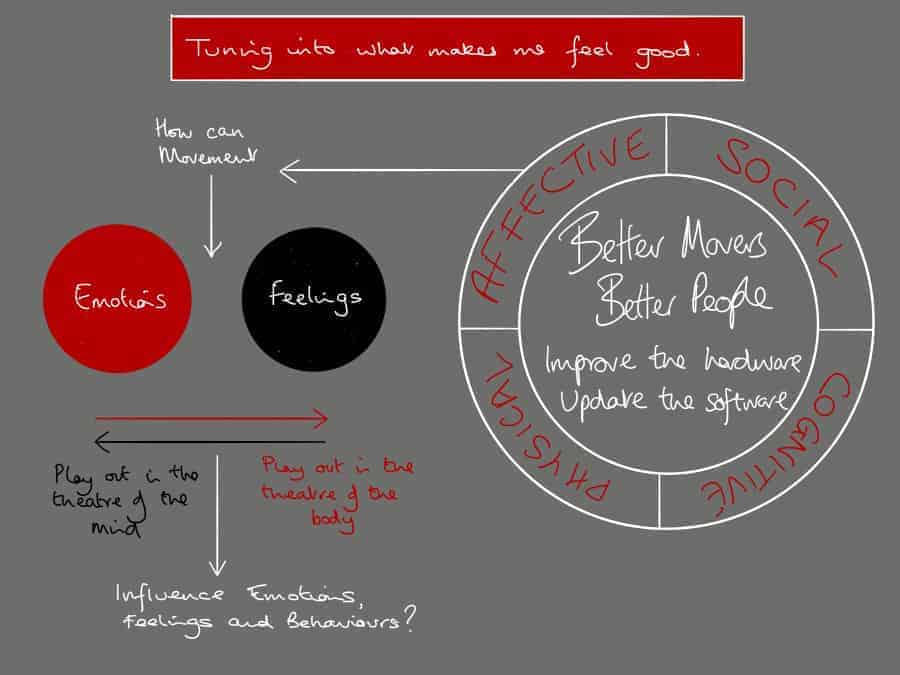
JOC: This is nice. Did you share this with students? Workshop it? Brainstorm ideas within it? Challenge it as a group? I wonder what their pre-requisite understandings of emotions/feelings were? What language did they have to work with these concepts? Did they know what these were, how to define them, how to describe them? Sort of stuff that would be good to unpack for assessment. Ie. Write down as many words you can think of that would ‘describe’ an emotion during a movement of your choice. (This assesses at a lower more superficial level). Repeat for Feeling. Describe into your video, what you think the difference is between an emotion and a feeling and use examples. (this is more than just descriptive, it adds comparison and a level of depth) Or – What can you tell me about a movement you do frequently and the feelings it gives you? (This assesses application) How does this movement impact your emotions?
The classes I were working with were two classes of Year 8 (12-13-year-old) boys of mixed ability, organised into learning teams to help support each other during lessons and used for group discussion and group processing. Class size is 30 and the lessons took place in a fitness suite with a variety of equipment that pupils can use (kettlebells, dumbbells, bars, boxes, bands, TRX cables etc). They had previously been taught how to use the equipment appropriately and what ‘safe, controlled technique with a full range of movement’ looks on a range of foundational movements. They now had control over their own programme to run during the lessons to prepare then pass competency levels which allow them access to other equipment, harder exercises, greater volume and also more autonomy over the choice of exercises. The unit lasted for 6 lessons of 50 minutes.
Learning Intentions for Unit of Work
Primary – Affective: Can movement influence our emotions, feelings and behaviour?
Secondary – Physical: Develop movement efficiency in 7 foundational movements of squat, lunge, push, pull, hinge, twist and brace.
Pupils are following their own personal programmes to complete levelled competencies. Once passed pupils may start the next level programme and work towards the next set of competencies. This is done at their own pace, they decide when they are ready to have a go at the competency and then they hold themselves to account when passing.
JOC: How can movement… we know it can, but the deeper question is how. Also, think about what you want the students to be able to do. The learning intention should come with a kind of success criteria. Students will be able to describe how movement impacts their emotions and feelings and describe how these, in turn, impact their movement behaviour. Students are successful when they can use a range of descriptive terms that can be applied to emotions and feelings and when they can elaborate on the relationship between a selected movement, related feelings, emotions and ongoing behaviour. Students are successful when they can apply this across different movement examples and suggest implications for sustained movement behaviour.
Lesson 1
Introduction to feelings and emotions. Feelings are mental experiences of body states, which arise as the brain interprets emotions, themselves physical states arising from the body’s responses to external stimuli. Emotions play out in the theatre of the body. Feelings play out in the theatre of the mind. Going to look how movement might change our feelings, emotions and behaviour. Spoke to them about which feelings that are important to me when I’m having a good/successful day. I’m calm, awake and positive. Naturally, I have the opposite feelings when I’m having a bad day. Got the class then to self-reflect and score themselves out of 1 – 10 (10 being high) on how they perceived they felt on the three that I shared with them before they performed any movement. Repeated at the end of the lesson after movement. Class discussion was about whether they felt more or less of the feeling after moving and why that might be. Key was that movement was having a physiological response which then was having an impact on their mental representation of how they were feeling.
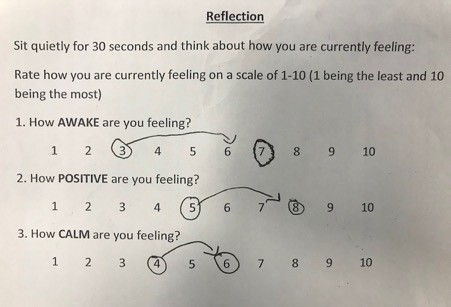
JOC: This is a good process. The one thing it isn’t developing is a rich vocabulary or language of emotion. There is no use of descriptive words. You could model some of these and get them to build on their list as they experience movement. You could have a class list going and when they feel something during movement they go and add their feeling to the list. You can ask them how that felt in different ways and then record their responses on the chart. So they build a language of feelings. They could then select 3 or more of their own feeling targets for the lesson, rate themselves, then do the exercise and reflect on these. They could add and remove items as they feel they are most relevant on any given day. Maybe they come on Tuesday and they have had a fight with a friend and they want to relieve some pent up aggression? On a Thursday they might be calm and want to get a kick-start for the day? This opens up the language and gives them more control.
Lesson 2 and 3
Followed a similar format. At the end of the third lesson, I shared with them the group data from both classes and this was used as a provocation for discussion. Discussion centred around calmness and although the data showed on average people felt calmer after movement, it was one where people had a negative response as well as a positive response. I asked them to think about what three feelings are important to them when they are having a good or successful day and come prepared to the next lesson to explore how movement might influence those feelings.
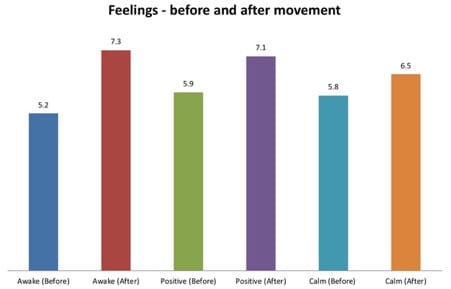
JOC: Not clear to me if this is feeling emotionally or physically. You make the distinction earlier but now it seems to be lost. I think you could tease these two things out. Emotions during movement: Pressure, gravity, squashed, resistance, instability, fatigue, running out, tired, exhaustion, pounding, breathless. Force, shifting weight, balanced, stable, powerful, explosive, controlled, relief, release, resistance, aligned, functional, comfortable. Feelings during movement: Fear, anxiety, stress, helplessness, overwhelmed, unsure, uncertain, doubtful, scared, humiliated, worried, subdued. Supported, powerful, optimally challenged, alert, energised, excited, in a flow state, enthused, hopeful, certain, calm, clear.
Lessons 4 to 6
Followed the same format as the first three lessons, but this time though instead of reflecting on my feelings of importance, they reflected on their own. This meant the majority of my lesson was spent either supporting movement efficiency, control, technique and range of movement or engaging in conversations about the feelings they felt were important and trying to get the clarity on what they meant by them. I tried to finish with group discussion like I had in lessons 1 to 3. Now with the change of focus on their feelings as opposed to my feelings they didn’t want to engage in learning team group discussions. Both classes I taught felt uncomfortable discussing their feelings in front of others. Two key things came out of this. They felt it was important to think about their feelings and how movement might have a positive or negative impact on them, as it might help them make positive choices. However, the discomfort they had when discussing their feelings was put down to ‘cultural’ issues. It wasn’t right for a ‘man’ to converse with other ‘men’ about how they feel.
JOC: What a powerful thing to do. So this is quite amazing and you could definitely unpack some gender stereotypes here. I think this suggests you need to do some front-loading to create an environment where it safe to talk about feelings. This could take a couple of sessions. Obviously, this video is probably too much but there are ads/resources done by prominent sports identities where they say it is ok to talk about your feelings. I would suggest if you start out by talking about feelings in relation to the physical aspects of movement, this might be a good place to start because it isn’t tied to identity. Focus on the actual physical bodily sensations first as mentioned up above. Then you can start to draw links to emotions/feelings and motivation. Another way you can do this is to talk about brain chemistry and emotions. Discussing brain chemistry takes away the idea that emotions are tied to gender and gives it a fairly concrete base to work from. The DOSE hormones – Dopamine, Oxytocin, Serotonin and Endorphins. Perhaps this more technical approach to explaining feelings will be less confrontational and an affront to masculine identity.
